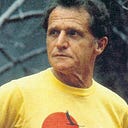The Mission Has Been Completed…
Sept. 10, 2020 — Sixty years ago today, on September 10th, 1960, the marathon race for the 17th Olympiad was contested around the cobblestone ancient streets of Rome in the semi-dark condition. In other words, not an ideal condition for a fast marathon…so they thought. It was a show-case for the city of Rome; you start right in front of Piazza Campidoglio where statues created by Michelangelo overlooking the athletes; go around the tourist course more than a marathon course; and back in the city to complete the 26-mile journey right next to the famous Colosseum; at the base of Arc de Constantine.
New Zealand team had 3 runners in the field; Jeff Julian was a seasoned veteran road runner; Ray Puckett was a tough runner over roads and countries…. And the third man was a relative novice in the marathon — more of a track man — Barry Magee. All 3 men were coached by Arthur Lydiard although he wasn’t even given the official “coach” status. “We were all running for New Zealand; and we were all running for Lydiard,” Magee said. They were all well-prepared to compete. Unfortunately, however, maybe too well…. “This is the special one,” Magee said to me. “So Julian and Puckett doubled the effort and perhaps did too much…. But I just carried on with regular training.” Coupled with digestion problem (they weren’t used to exotic foods), Julian and Puckett didn’t perform up to their level (“Puckett was so tough; I’d rather compete against the Olympic champion than Puckett,” Magee told me). Magee kept his cool however. “The course was dark and I had no idea where (what place) I was running,” recalls Magee.
This was a historic marathon competition with a historic performance; an Ethiopian complete-unknown runner, Abebe Bikila, ran the entire 26-miles barefoot, and ran the fastest marathon time of 2:15:16 at the time. Interestingly, there has been a debate whether Abebe started the race barefoot or he actually had shoes on at first but, after a few miles, didn’t feel right so he took them off. “He was barefoot at the start,” Ray Puckett told me. “This African guy was standing right next to me at the start and he didn’t have any shoes on,” Puckett says. “I thought, ‘Bloody hell!!’…”. If you watch the clip (watch it HERE), you can see Abebe’s close-up at 13-seconds into the clip. Standing right next to him was Jeff Julian. Magee had #15, Puckett#13 bib number and Abebe was #11.
Team Lydiard had 2 gold medals won a week earlier (see my earlier blog HERE). Lydiard thought Magee could have gotten the silver had he known where he and other runners were during the race. “But Abebe seemed invincible,” Lydiard admitted. Nonetheless, yet another Olympic medal for a group of runners from the small region of Auckland, New Zealand, all trained by an unofficial “coach” who didn’t even obtain his credential. “The mission has been completed,” Magee says. New Zealand team had 9 athletes in Track & Field. Five of them were coached by Lydiard. They claimed two gold medals and one bronze.
Coincidentally, 12 years later on the same day, September 10th, 1972, two more gold medals would be won by Lydiard-influenced runners from Finland where Lydiard served as a national coach earlier; Lasse Viren would win 5000m and Pekka Vasala 1500m. Also, America’s Frank Shorter would win the marathon gold medal and ignited the nation-wide running movement in the USA in the years and decades to come and eventually to the world. I remember watching this marathon race on TV(I was rooting for Japan’s Akio Usami) and watching Shorter winning Fukuoka Marathon a few months later inspired me to running. — Nobby Hashizume
